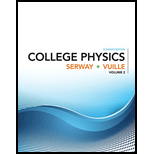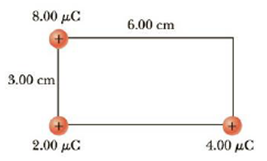
COLLEGE PHYSICS,V.2
11th Edition
ISBN: 9781305965522
Author: SERWAY
Publisher: CENGAGE L
expand_more
expand_more
format_list_bulleted
Concept explainers
Textbook Question
Chapter 16, Problem 13P
(a) Find the electric potential, taking zero at infinity, at the upper right corner (the corner without a charge) of the rectangle in Figure P16.13. (b) Repeat if the 2.00-μC charge is replaced with a charge of −2.00 μC.

Figure P16.13 Problems 13 and 14.
Expert Solution & Answer
Trending nowThis is a popular solution!

Students have asked these similar questions
Can someone help me with this question. Thanks.
Can someone help me with this question. Thanks.
Can someone help me with this question. Thanks.
Chapter 16 Solutions
COLLEGE PHYSICS,V.2
Ch. 16.1 - If an electron is released from rest in a uniform...Ch. 16.1 - If a negatively charged particle is placed at rest...Ch. 16.1 - Figure 16.3 is a graph of an electric potential as...Ch. 16.1 - If a negatively charged particle is placed at...Ch. 16.2 - Consider a collection of charges in a given region...Ch. 16.2 - A spherical balloon contains a positively charged...Ch. 16.3 - An electron initially at rest accelerates through...Ch. 16.6 - A capacitor is designed so that one plate is large...Ch. 16.7 - A parallel-plate capacitor is disconnected from a...Ch. 16.8 - A fully charged parallel-plate capacitor remains...
Ch. 16.8 - Consider a parallel-plate capacitor with a...Ch. 16 - A proton is released from rest in a uniform...Ch. 16 - An electron is released from rest in a uniform...Ch. 16 - Figure CQ16.3 shows equipotential contours in the...Ch. 16 - Rank the potential energies of the four systems of...Ch. 16 - A parallel-plate capacitor with capacitance C0...Ch. 16 - An air-filled parallel-plate capacitor with...Ch. 16 - Choose the words that make each statement correct,...Ch. 16 - Why is it important to avoid sharp edges or points...Ch. 16 - Explain why, under static conditions, all points...Ch. 16 - If you are given three different capacitors C1,...Ch. 16 - (a) Why is it dangerous to touch the terminals of...Ch. 16 - The plates of a capacitor are connected to a...Ch. 16 - Rank the electric potentials at the four points...Ch. 16 - If you were asked to design a capacitor in which...Ch. 16 - Is it always possible to reduce a combination of...Ch. 16 - Explain why a dielectric increases the maximum...Ch. 16 - A uniform electric field of magnitude 375 N/C...Ch. 16 - A proton is released from rest in a uniform...Ch. 16 - A potential difference of 90.0 mV exists between...Ch. 16 - Cathode ray tubes (CRTs) used in old-style...Ch. 16 - A constant electric field accelerates a proton...Ch. 16 - A point charge q = +40.0 C moves from A to B...Ch. 16 - Oppositely charged parallel plates are separated...Ch. 16 - (a) Find the potential difference VB required to...Ch. 16 - An ionized oxygen molecule (O+2) at point A has...Ch. 16 - On planet Tehar, the free-fall acceleration is the...Ch. 16 - An electron is at the origin, (a) Calculate the...Ch. 16 - The two charges in Figure P16.12 are separated by...Ch. 16 - (a) Find the electric potential, taking zero at...Ch. 16 - Three charges are situated at corners of a...Ch. 16 - Two point charges Q1 = +5.00 nC and Q2 = 3.00 nC...Ch. 16 - Three identical point charges each of charge q are...Ch. 16 - The three charges in Figure P16.17 are at the...Ch. 16 - A positive point charge q = +2.50 nC is located at...Ch. 16 - A proton is located at the origin, and a second...Ch. 16 - A proton and an alpha particle (charge = 2e, mass...Ch. 16 - A tiny sphere of mass 8.00 g and charge 2.80 nC is...Ch. 16 - The metal sphere of a small Van de Graaff...Ch. 16 - In Rutherfords famous scattering experiments that...Ch. 16 - Four point charges each haring charge Q are...Ch. 16 - Calculate the speed of (a) an electron and (b) a...Ch. 16 - An electric field does 1.50 103 eV of work on a...Ch. 16 - An alpha particle, which has charge 3.20 1019 C,...Ch. 16 - In the classical model of a hydrogen atom, an...Ch. 16 - Consider the Earth and a cloud layer 8.0 102 m...Ch. 16 - (a) When a 9.00-V battery is connected to the...Ch. 16 - An air-filled parallel-plate capacitor has plates...Ch. 16 - Air breaks down and conducts charge as a spark if...Ch. 16 - An air-filled capacitor consists of two parallel...Ch. 16 - A 1-megabit computer memory chip contains many...Ch. 16 - a parallel-plate capacitor with area 0.200 m2 and...Ch. 16 - A small object with a mass of 350. g carries a...Ch. 16 - Given a 2.50-F capacitor, a 6.25-F capacitor, and...Ch. 16 - Two capacitors, C1 = 5.00 F and C2 = 12.0 F, are...Ch. 16 - Find (a) the equivalent capacitance of the...Ch. 16 - Two capacitors give an equivalent capacitance of...Ch. 16 - For the system of capacitors shown in Figure...Ch. 16 - Consider the combination of capacitors in Figure...Ch. 16 - Find the charge on each of the capacitors in...Ch. 16 - Three capacitors are connected to a battery as...Ch. 16 - A 25.0-F capacitor and a 40.0-F capacitor are...Ch. 16 - (a) Find the equivalent capacitance between points...Ch. 16 - A 1.00-F capacitor is charged by being connected...Ch. 16 - Four capacitors are connected as shown in Figure...Ch. 16 - A 12.0 V battery is connected to a 4.50 F...Ch. 16 - Two capacitors, C1 = 18.0 F and C2 = 36.0 F, are...Ch. 16 - A parallel-plate capacitor has capacitance 3.00 F....Ch. 16 - Each plate of a 5.00 F capacitor stores 60.0 C of...Ch. 16 - The voltage across an air-filled parallel-plate...Ch. 16 - (a) How much charge can be placed on a capacitor...Ch. 16 - Determine (a) the capacitance and (b) the maximum...Ch. 16 - A parallel-plate capacitor has plates of area A =...Ch. 16 - A model of a red blood cell portrays the cell as a...Ch. 16 - When a potential difference of 150. V is applied...Ch. 16 - Three parallel-plate capacitors are constructed,...Ch. 16 - For the system of four capacitors shown in Figure...Ch. 16 - A parallel-plate capacitor with a plate separation...Ch. 16 - Two capacitors give an equivalent capacitance of...Ch. 16 - A parallel-plate capacitor is constructed using a...Ch. 16 - Two charges of 1.0 C and 2.0 C are 0.50 m apart at...Ch. 16 - Find the equivalent capacitance of the group of...Ch. 16 - A spherical capacitor consists of a spherical...Ch. 16 - The immediate cause of many deaths is ventricular...Ch. 16 - When a certain air-filled parallel-plate capacitor...Ch. 16 - Capacitors C1 = 6.0 F and C2 = 2.0 F are charged...Ch. 16 - Two positive charges each of charge q are fixed on...Ch. 16 - Metal sphere A of radius 12.0 cm carries 6.00 C of...Ch. 16 - An electron is fired at a speed v0 = 5.6 106 m/s...
Knowledge Booster
Learn more about
Need a deep-dive on the concept behind this application? Look no further. Learn more about this topic, physics and related others by exploring similar questions and additional content below.Similar questions
- Identical rays of light enter three transparent blocks composed of different materials. Light slows down upon entering the blocks.arrow_forwardFor single-slit diffraction, calculate the first three values of (the total phase difference between rays from each edge of the slit) that produce subsidiary maxima by a) using the phasor model, b) setting dr = 0, where I is given by, I = Io (sin (10) ². 2arrow_forwardA capacitor with a capacitance of C = 5.95×10−5 F is charged by connecting it to a 12.5 −V battery. The capacitor is then disconnected from the battery and connected across an inductor with an inductance of L = 1.55 H . (D)What is the charge on the capacitor 0.0235 s after the connection to the inductor is made? Interpret the sign of your answer. (e) At the time given in part (d), what is the current in the inductor? Interpret the sign of your answer. (f) Atthe time given in part (d), how much electrical energy is stored in the capacitor and how much is stored in the inductor?arrow_forward
arrow_back_ios
SEE MORE QUESTIONS
arrow_forward_ios
Recommended textbooks for you
 Principles of Physics: A Calculus-Based TextPhysicsISBN:9781133104261Author:Raymond A. Serway, John W. JewettPublisher:Cengage Learning
Principles of Physics: A Calculus-Based TextPhysicsISBN:9781133104261Author:Raymond A. Serway, John W. JewettPublisher:Cengage Learning Physics for Scientists and Engineers: Foundations...PhysicsISBN:9781133939146Author:Katz, Debora M.Publisher:Cengage Learning
Physics for Scientists and Engineers: Foundations...PhysicsISBN:9781133939146Author:Katz, Debora M.Publisher:Cengage Learning Physics for Scientists and Engineers, Technology ...PhysicsISBN:9781305116399Author:Raymond A. Serway, John W. JewettPublisher:Cengage Learning
Physics for Scientists and Engineers, Technology ...PhysicsISBN:9781305116399Author:Raymond A. Serway, John W. JewettPublisher:Cengage Learning College PhysicsPhysicsISBN:9781305952300Author:Raymond A. Serway, Chris VuillePublisher:Cengage Learning
College PhysicsPhysicsISBN:9781305952300Author:Raymond A. Serway, Chris VuillePublisher:Cengage Learning Physics for Scientists and Engineers with Modern ...PhysicsISBN:9781337553292Author:Raymond A. Serway, John W. JewettPublisher:Cengage Learning
Physics for Scientists and Engineers with Modern ...PhysicsISBN:9781337553292Author:Raymond A. Serway, John W. JewettPublisher:Cengage Learning Physics for Scientists and EngineersPhysicsISBN:9781337553278Author:Raymond A. Serway, John W. JewettPublisher:Cengage Learning
Physics for Scientists and EngineersPhysicsISBN:9781337553278Author:Raymond A. Serway, John W. JewettPublisher:Cengage Learning

Principles of Physics: A Calculus-Based Text
Physics
ISBN:9781133104261
Author:Raymond A. Serway, John W. Jewett
Publisher:Cengage Learning

Physics for Scientists and Engineers: Foundations...
Physics
ISBN:9781133939146
Author:Katz, Debora M.
Publisher:Cengage Learning

Physics for Scientists and Engineers, Technology ...
Physics
ISBN:9781305116399
Author:Raymond A. Serway, John W. Jewett
Publisher:Cengage Learning

College Physics
Physics
ISBN:9781305952300
Author:Raymond A. Serway, Chris Vuille
Publisher:Cengage Learning

Physics for Scientists and Engineers with Modern ...
Physics
ISBN:9781337553292
Author:Raymond A. Serway, John W. Jewett
Publisher:Cengage Learning

Physics for Scientists and Engineers
Physics
ISBN:9781337553278
Author:Raymond A. Serway, John W. Jewett
Publisher:Cengage Learning
Electric Fields: Crash Course Physics #26; Author: CrashCourse;https://www.youtube.com/watch?v=mdulzEfQXDE;License: Standard YouTube License, CC-BY